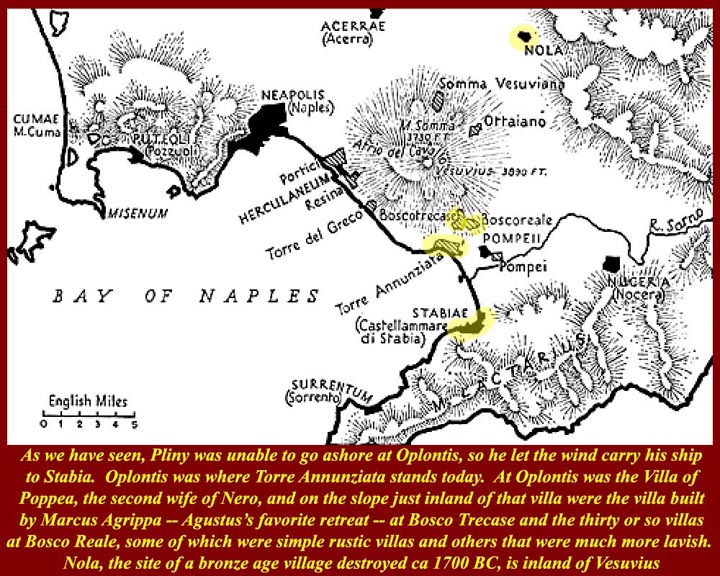 The map shows the
places, highlighted in yellow, that are covered in this unit.
The map shows the
places, highlighted in yellow, that are covered in this unit.
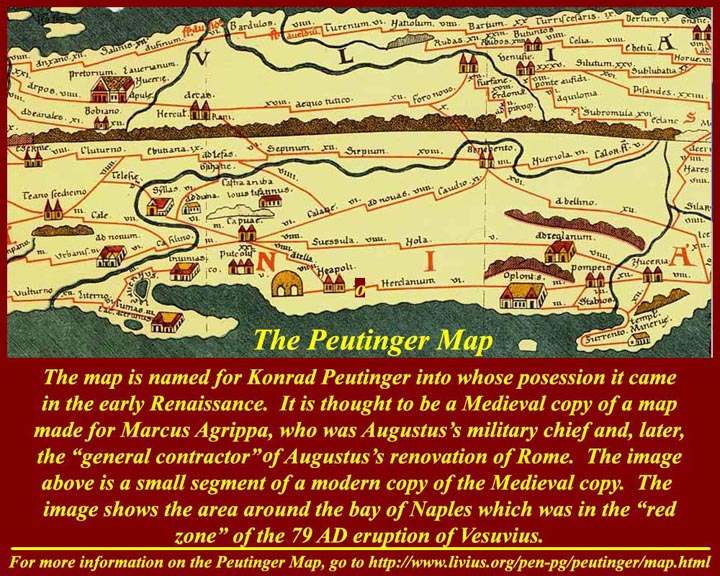
http://www.mmdtkw.org/ALRIVes0602PeutingerMap.jpg
Oplontis first shows up on the Peutinger Map, a Medieval copy of
the map put on display by Agrippa, Caesar's Chief of Staff
and an early candidate for the succession. The map came
into Peutinger's possession early in the Renaissance and has
borne his name ever since. (This is a part of a modern
copy of the Peutinger map.) The green area is the sea, and
the part of the green that looks like an alligator with its nose
pointed to the left is the Bay of Naples.
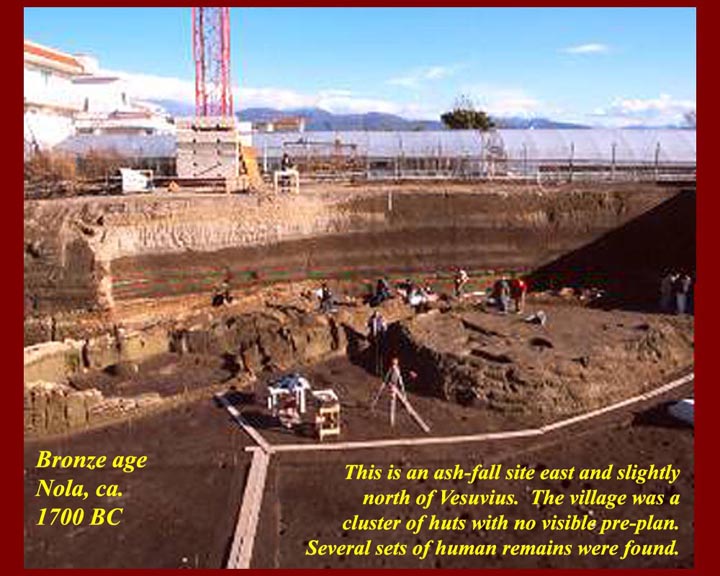
http://www.mmdtkw.org/ALRIVes0603NolaBronze1700BC.jpg
The bronze age village at Nola, east and slightly north of
Vesuvius, was discovered under a thick layer of volcanic ash
from an eruption about 1700 BC (see image) while a building
foundation was being excavated. Archeologists had found
other ruins from the 1700 BC Eruption, but these were certainly
the best: whole buildings were preserved as well as a goat
pens, a pottery kiln with a pot still inside, and numerous
artifacts.
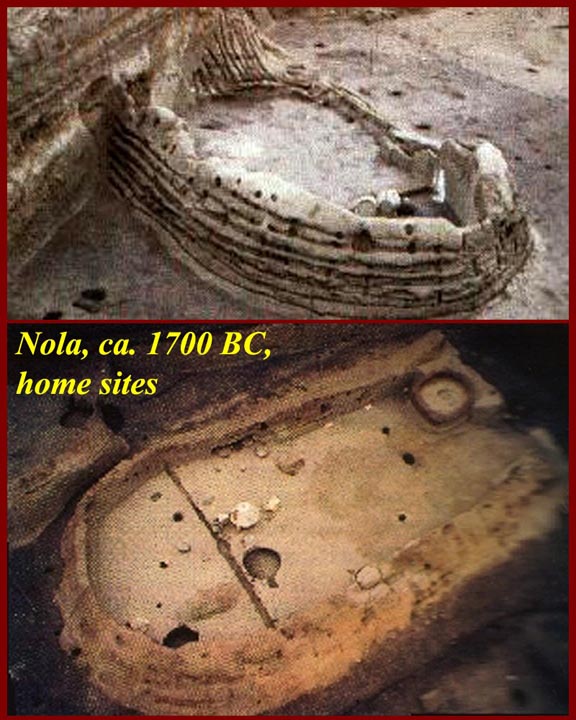
http://www.mmdtkw.org/ALRIVes0604NolaVillage17cBC.jpg
The Nola site is the best preserved bronze age site
in Italy. These are two huts -- "long houses" -- each
of which may have housed more than one family or an extended
family group. The upper hut is about 24 feel long, and the
lower one is about 50 feet long. Each is divided into two
rooms, a living area and a storage area (further from the
entrance. The Nola/Croce del Papa/Avelino eruption details
are all over the internet. A simple earch will find more
than you ever wanted to know.
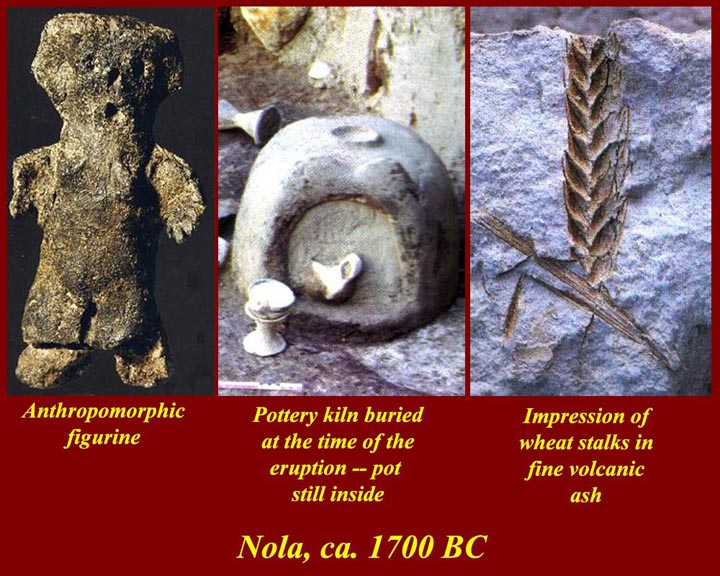
http://www.mmdtkw.org/ALRIVes0605Nola1700BC.jpg
(not to scale)
Artifacts and plant material from Nola: Human figure,
found at the bronze age level, may actually be older and may
have been preserved frome earlier times as a cult object.
The pottery kiln, about two feet high and buried
during the eruption, still had a pot inside. Stalks of
wheat were buried and carbonized.
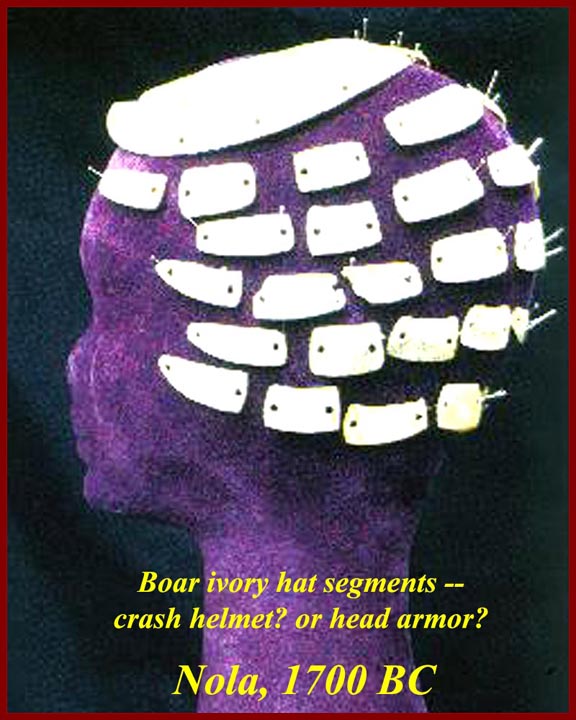
http://www.mmdtkw.org/ALRIVes0606BoarIvoryHat170.jpg
A boars' teeth cap or helmet, reconstructed, from bronze age
Nola. It may have been ceremonial or may have been a
protective battle helmet.
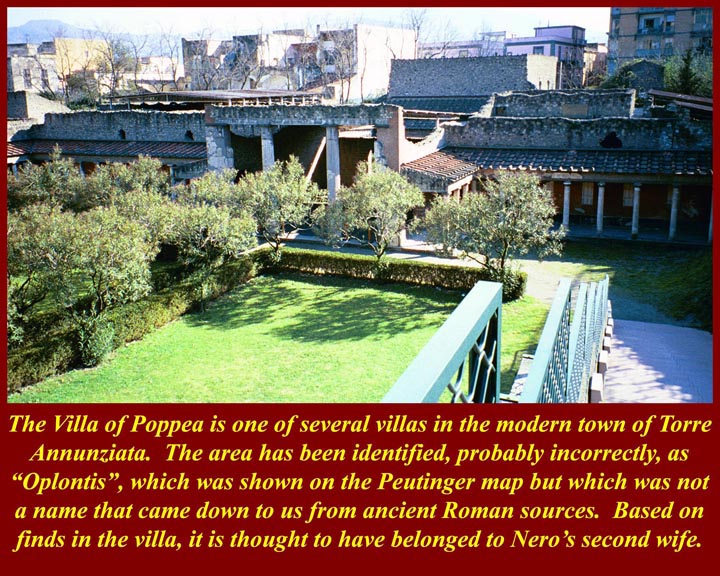 http://www.mmdtkw.org/ALRIVes0607OplontisVillaPoppea.jpg
http://www.mmdtkw.org/ALRIVes0607OplontisVillaPoppea.jpg
Oplontis: A sumptuous villa that probably belonged
to Nero's second wife, Poppea, in modern Torre Annunziata.
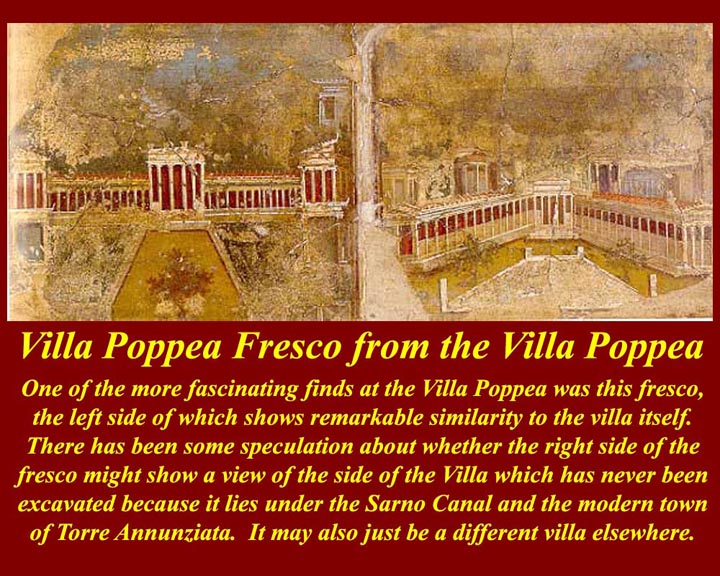 http://www.mmdtkw.org/ALRIVes0608PoppeaVillaFresco.jpg
http://www.mmdtkw.org/ALRIVes0608PoppeaVillaFresco.jpg
Fresco from inside the Poppea villa -- now in the Naples
National Archeological Museum -- shows two view of a villa, the
left of which looks remarkably like the exposed side of the Villa
of Poppea. The other side (front entrance side?) is still
buried under the Sarno River Canal and the modern city, so there's
no way to tell whether it looked like the right side of the image.
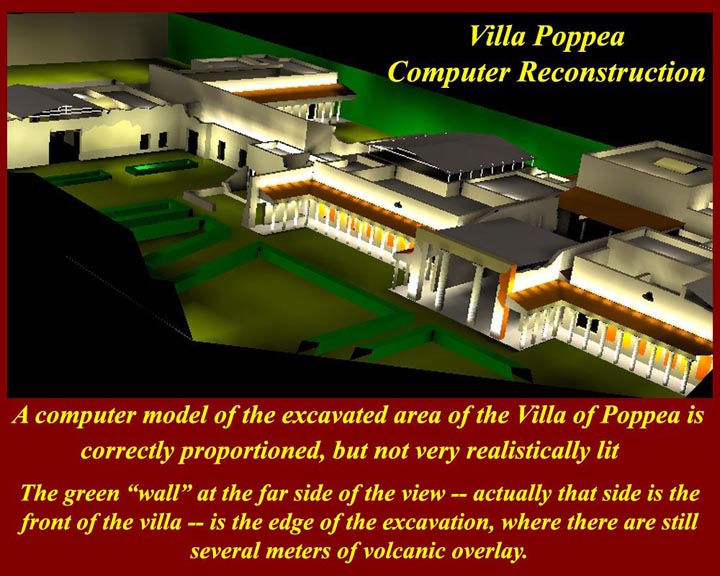 http://www.mmdtkw.org/ALRIVes0609VillaPoppeaReconst.jpg
http://www.mmdtkw.org/ALRIVes0609VillaPoppeaReconst.jpg
A computer generated view of Poppea's villa. The
green wall away from the viewer is the still unexcavated volcanic
debris. The lighting is a modern effect that allows viewing
of the site at night.
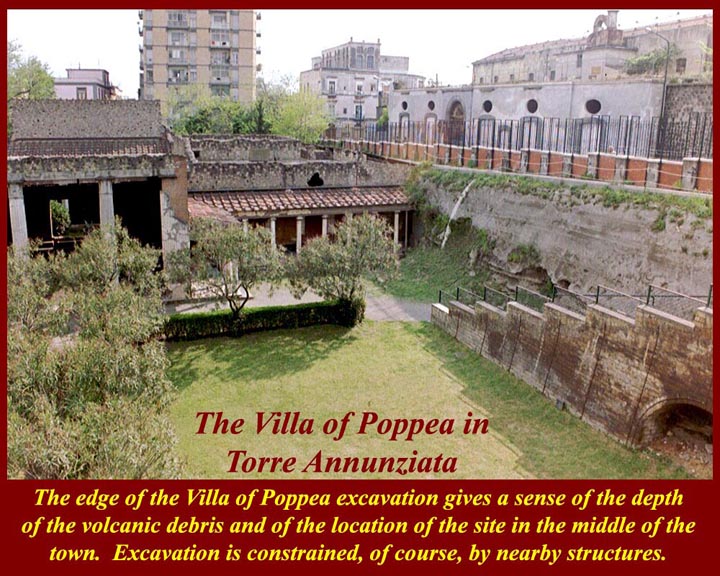 http://www.mmdtkw.org/ALRIVes0610PoppeaVolcDeposit.jpg
http://www.mmdtkw.org/ALRIVes0610PoppeaVolcDeposit.jpg
At the right side is the debris wall, and above it is the town
of Torre Annunziata.
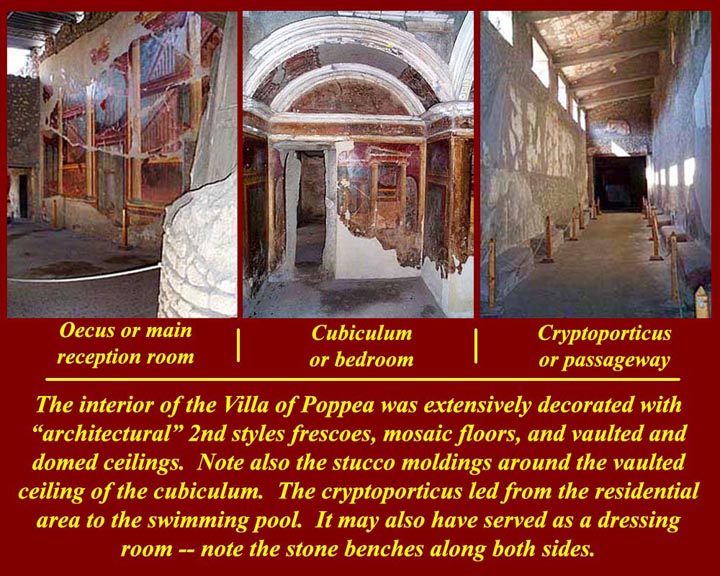 http://www.mmdtkw.org/ALRIVes0611PoppeaOecus.jpg
http://www.mmdtkw.org/ALRIVes0611PoppeaOecus.jpg
Three views inside the Villa of Poppea: the Oecus or
main entertainment space (where large meals could be held, for
example), a cubiculum or bedroom (note the stucco decorations
around the ceiling), and the underground cryptoporticus passage
between the living quarters and the pool.
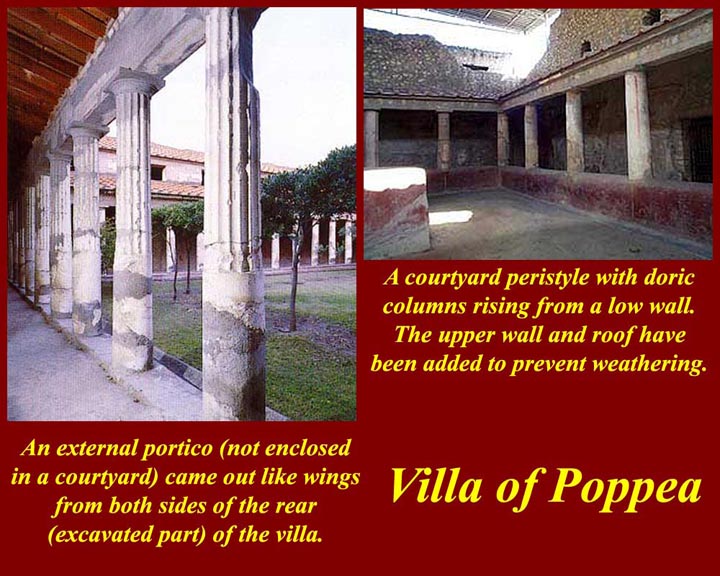 http://www.mmdtkw.org/ALRIVes0612PoppeaPeristyles.jpg
http://www.mmdtkw.org/ALRIVes0612PoppeaPeristyles.jpg
An external portico with half-fluted columns. A perisyle
courtyard.
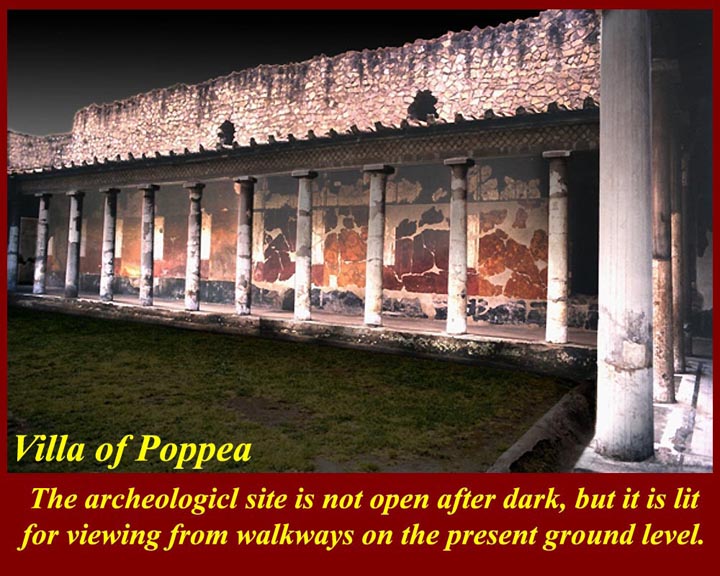 http://www.mmdtkw.org/ALRIVes0613PoppeaPeristyleLit.jpg
http://www.mmdtkw.org/ALRIVes0613PoppeaPeristyleLit.jpg
The archeological site is not open after dark, but it is lit
for viewing from the walkways above, at the modern ground level.
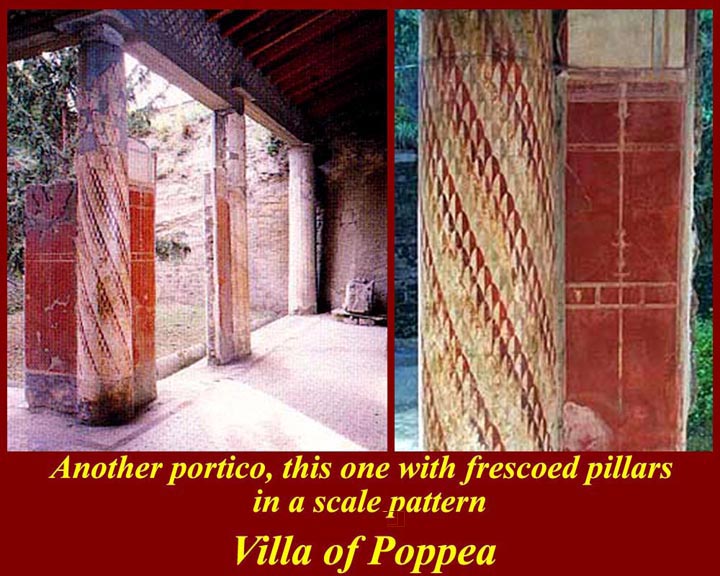 http://www.mmdtkw.org/ALRIVes0614PoppeaPortico.jpg
http://www.mmdtkw.org/ALRIVes0614PoppeaPortico.jpg
Another Villa Poppea peristyle, this one with stuccoed columns
in a feather pattern.
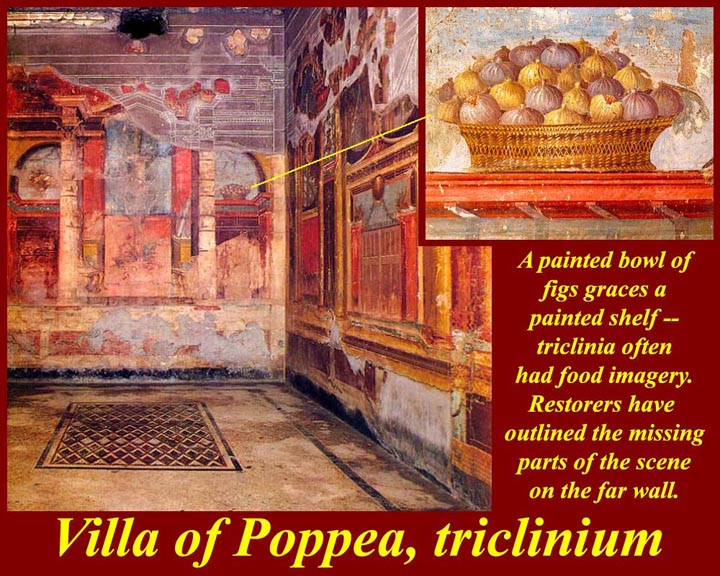 http://www.mmdtkw.org/ALRIVes0615PoppeaTriclinium.jpg
http://www.mmdtkw.org/ALRIVes0615PoppeaTriclinium.jpg
In triclinia dining rooms, food was often part of the
decorations: here, a painted basket of fruit on a painted
shelf. Restorers have inscribed the upper wall to complete
the architectural pattern of the fresco.
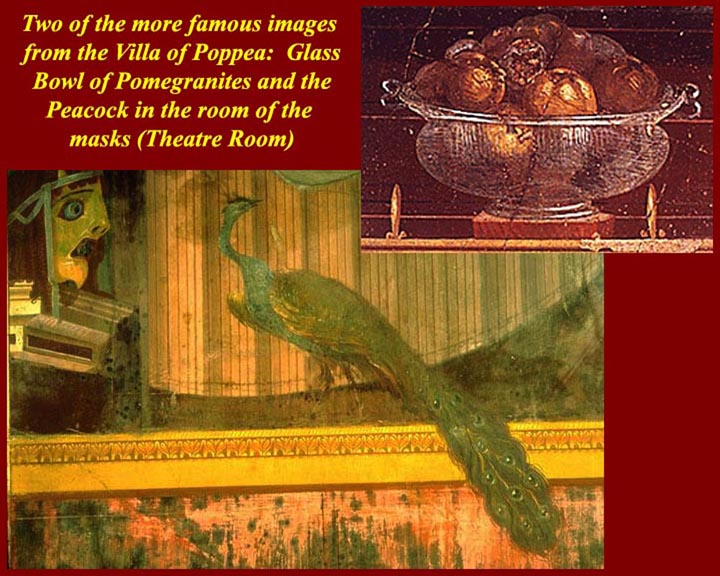 http://www.mmdtkw.org/ALRIVes0616PeacockGlassBowl.jpg
http://www.mmdtkw.org/ALRIVes0616PeacockGlassBowl.jpg
Two of the Villa's more famous artworks: pomegranates in
a glass bowl, and a peacock on the wall.
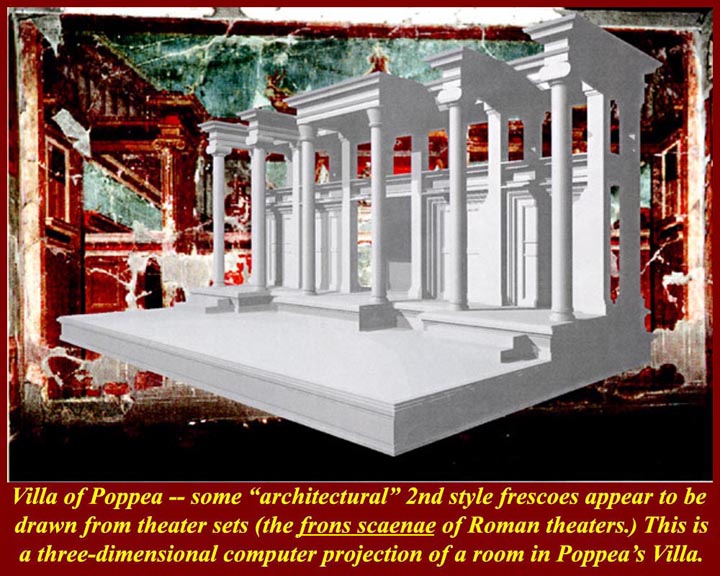 http://www.mmdtkw.org/ALRIVes0617PoppeaTheatrical.jpg
http://www.mmdtkw.org/ALRIVes0617PoppeaTheatrical.jpg
Architectural second style decoration is often described
as "theatrical". Here, modern archeologist-architects have
lifted the "set" from the wall in a three dimensional projection.
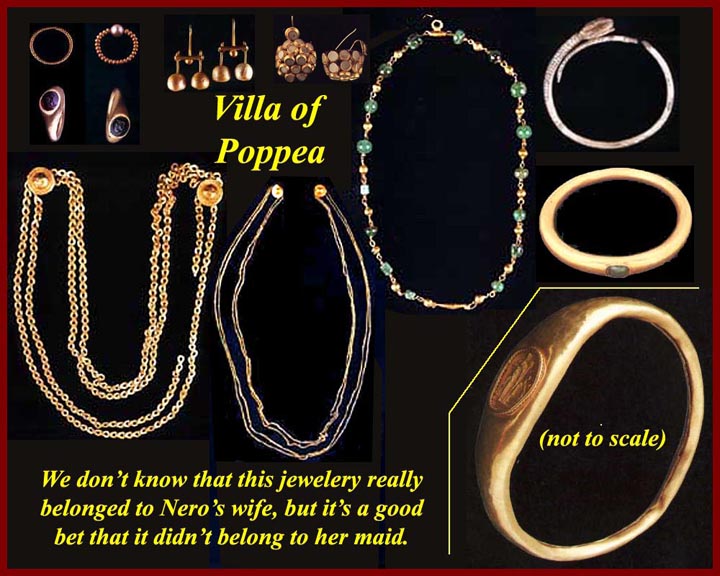
http://www.mmdtkw.org/ALRIVes0618PoppeaOplontisGold.jpg
Villa Poppea jewelry: (clockwise from upper left) rings,
two sets of earrings, an emerald necklace, three bracelets, and
two belts -- all in gold.
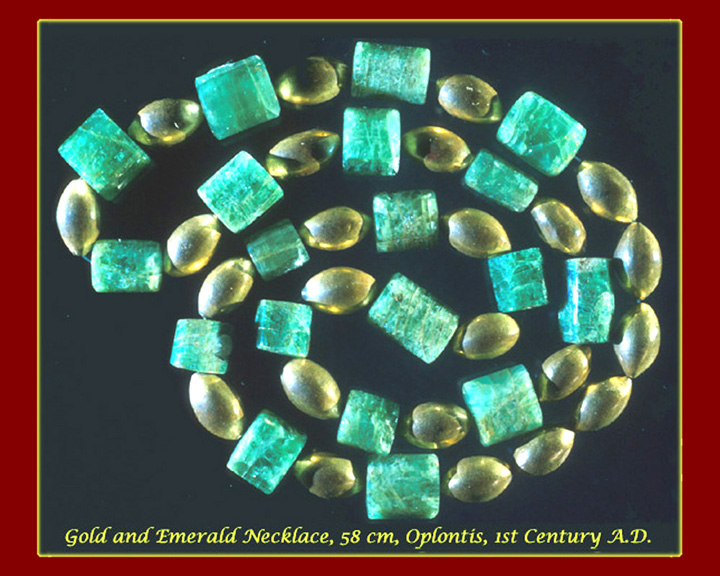 http://www.mmdtkw.org/ALRIVes0618AOplontisNecklace.jpg
http://www.mmdtkw.org/ALRIVes0618AOplontisNecklace.jpg
A gold and emerald neckace found with the body of an eruption
victim in "Villa B" in Oplontis -- go to
http://www.smatch-international.org/Fascinating.htm
for information on emeralds from
SMATCH.
There's a mystery here -- crystalographic tests indicate that some
of the emeralds burried in the 79 AD eruption of Vesuvius came
from Colombian mines.
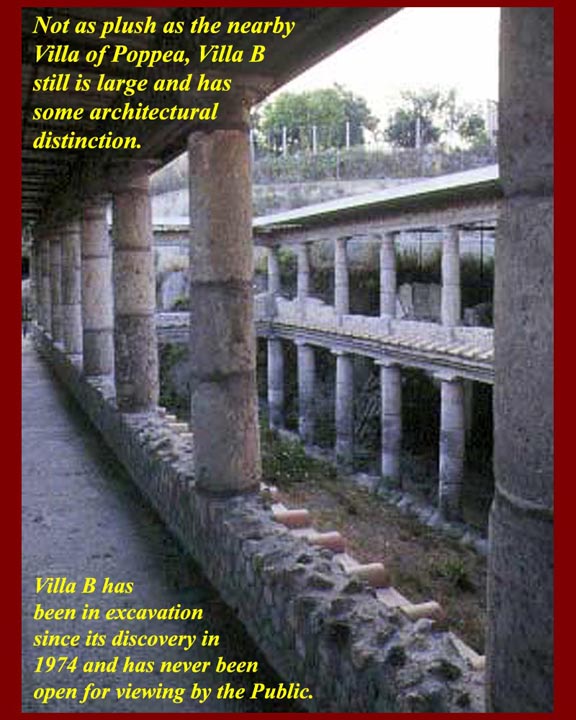 http://www.mmdtkw.org/ALRIVes0619LCrassius3Peristyle.jpg
http://www.mmdtkw.org/ALRIVes0619LCrassius3Peristyle.jpg
Villa B at Oplontis was not as big as Villa A ("of Poppea"),
but it had good architectural features like this long two level
peristyle courtyard. Discovered in 1974, it is still not
open to the public.
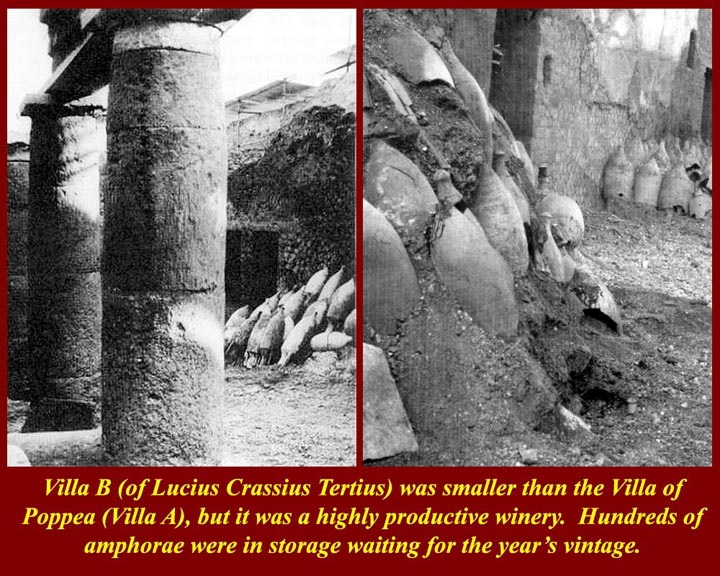 http://www.mmdtkw.org/ALRIVes0620LCrassius3Winery.jpg
http://www.mmdtkw.org/ALRIVes0620LCrassius3Winery.jpg
Like Villa A, Villa B was not inhabited at the time of the
eruption, because Villa B had been converted into a winery.
Wine amphorae, already coated on the inside with pine-pitch, were
stacked upside down, waiting for the year's vintage.
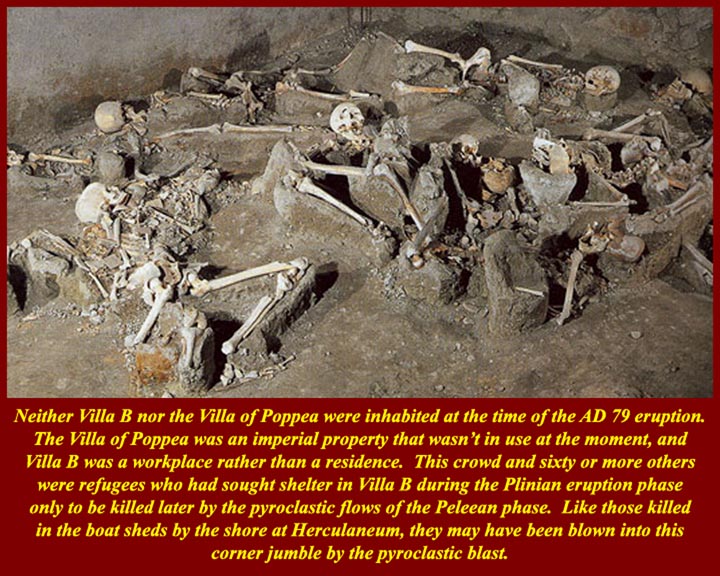 http://www.mmdtkw.org/ALRIVes0621LCrassius3Skeletons.jpg
http://www.mmdtkw.org/ALRIVes0621LCrassius3Skeletons.jpg
Although no landlord family was present (no furniture in the
living quarters) these and sixty or so others took shelter in the
villa during the eruption's Plinian phase only to be killed by the
pyroclastic flows that followed during the Peleean phase.
Like the bodies found in the boat sheds at Herculaneum, these
people may have been blasted into this corner by the first
surge-flow that hit the villa.
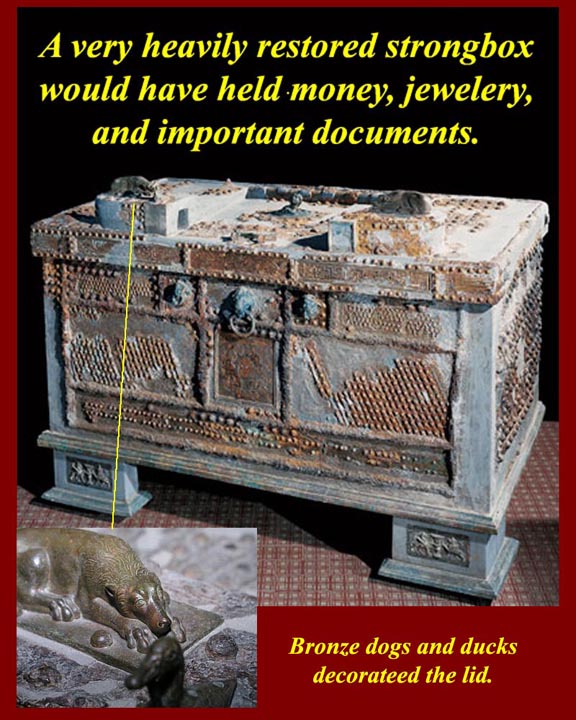 http://www.mmdtkw.org/ALRIVes0622LCrassius3StrongBox.jpg
http://www.mmdtkw.org/ALRIVes0622LCrassius3StrongBox.jpg
A strongbox of oak, iron, and bronze: it would
have held valuables and important papers.
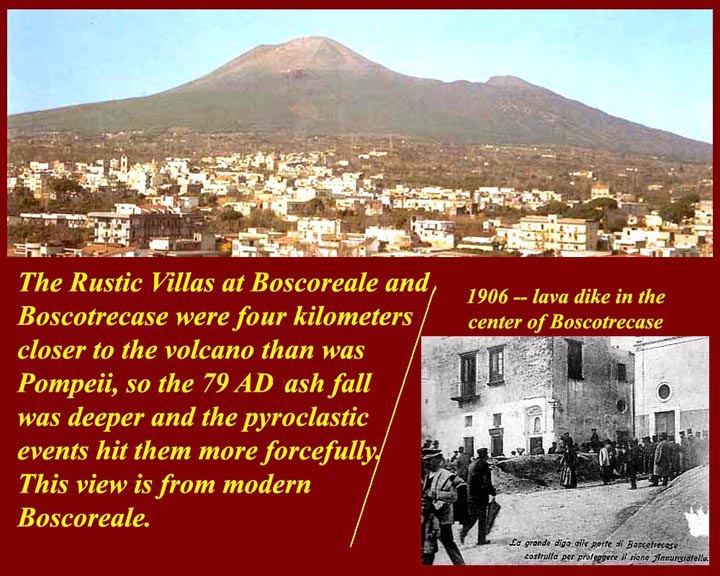 http://www.mmdtkw.org/ALRIVes0623BoscorealeView.jpg
http://www.mmdtkw.org/ALRIVes0623BoscorealeView.jpg
A view of Vesuvius from Boscoreale, a prominence on the
slope that held several large Villas. In the lower right
corner, one of the dikes built in the town to hold back lava from
the nearby town of Boscotrecase durin a 1906 eruption.
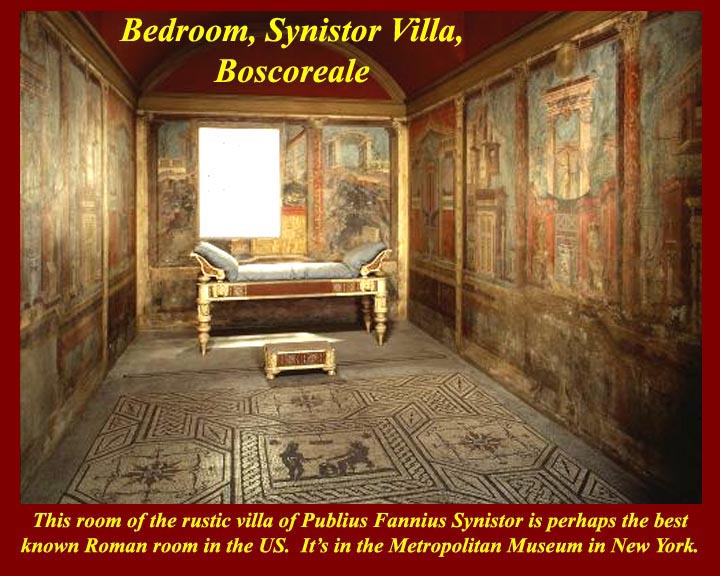
http://www.mmdtkw.org/ALRIVes0624SynistorBedroom.jpg
A room from the villa of Lucius Fannius Synistor in
Boscoreale, now in the Metropolitan Museum of Art in New york. See
https://www.metmuseum.org/art/collection/search/247017
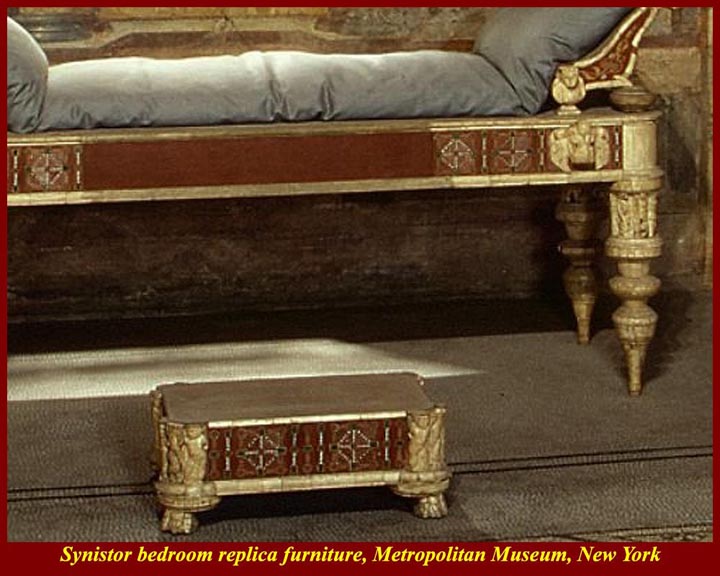 http://www.mmdtkw.org/ALRIVes0625SynistorBedroomFurn.jpg
http://www.mmdtkw.org/ALRIVes0625SynistorBedroomFurn.jpg
Replica bed and stool from the Synistor bedroom.
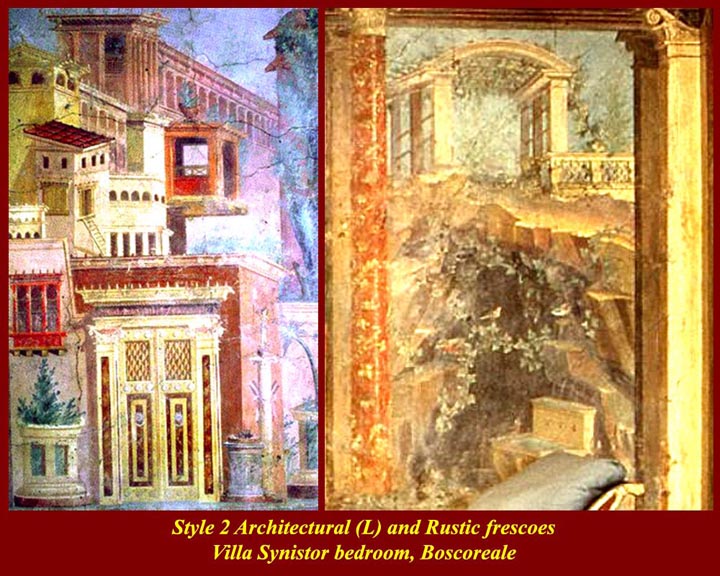 http://www.mmdtkw.org/ALRIVes0626SynistorBdrmStyle2.jpg
http://www.mmdtkw.org/ALRIVes0626SynistorBdrmStyle2.jpg
Style 2 architectural and rustic scenes from the Villa
Synistor bedroom.
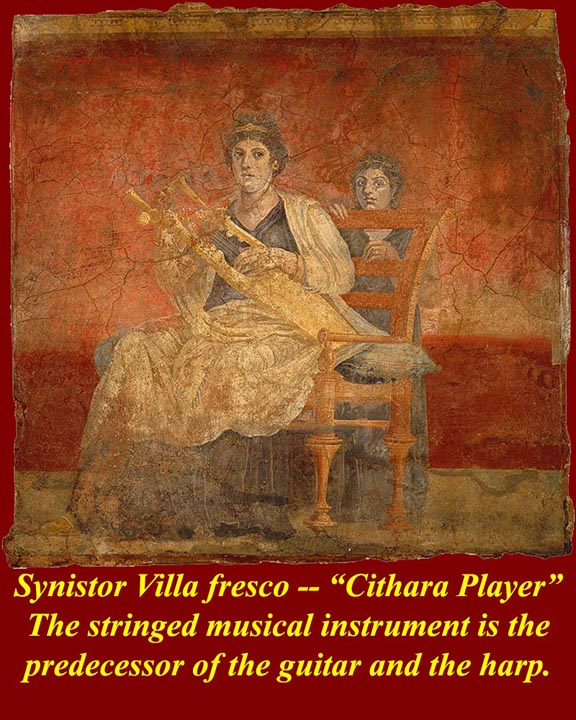 http://www.mmdtkw.org/ALRIVes0627SynistorCithara.jpg
http://www.mmdtkw.org/ALRIVes0627SynistorCithara.jpg
Woman with a
cithara,
(kithara), fresco from the Villa Synistor. The
stringed cithara was the predecessor of the harp and of the
guitar, the latter of which derived its name from
Kithara.
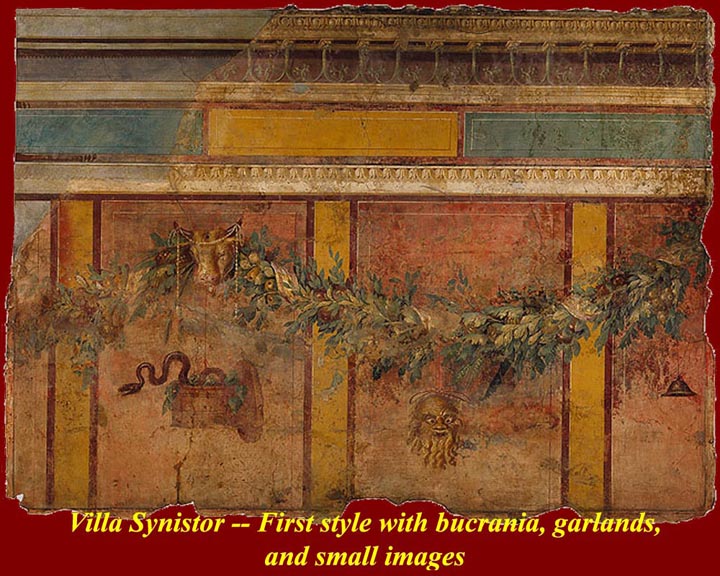 http://www.mmdtkw.org/ALRIVes0628SynistorGarlands.jpg
http://www.mmdtkw.org/ALRIVes0628SynistorGarlands.jpg
A Villa Synistor first style fresco: garlands, bucrania,
and small images on a faux marble background.
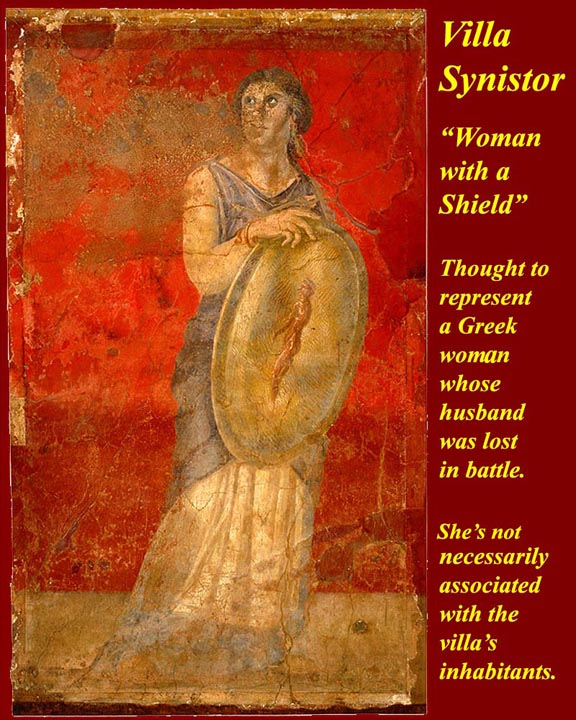 http://www.mmdtkw.org/ALRIVes0629WomanShield.jpg
http://www.mmdtkw.org/ALRIVes0629WomanShield.jpg
A woman with a shield: Greek woman mourning a husband
lost in battle. There is no necessary connection between the
image and any of the inhabitants of the house; this was a
repertoirial image.
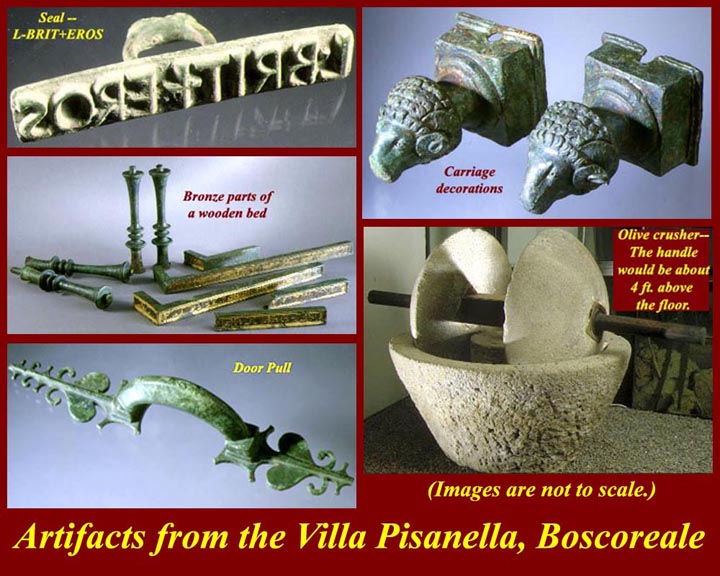 http://www.mmdtkw.org/ALRIVes0630PisanellaArtifacts.jpg
http://www.mmdtkw.org/ALRIVes0630PisanellaArtifacts.jpg
Artifacts from the Villa Pisanella: a name seal,
two carriage ornaments, a large olive crusher, a bronze door
handle, and bronze fittings for a bed. The villa was
excavated in the late 1890s and then re-buried.
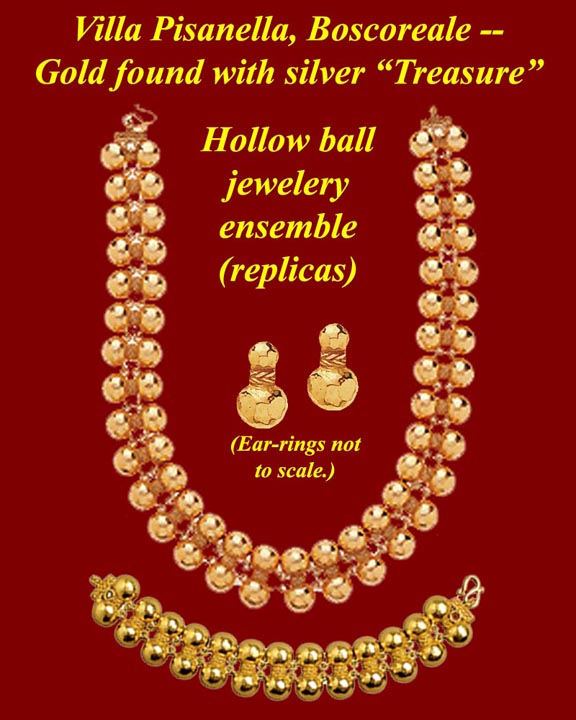 http://www.mmdtkw.org/ALRIVes0631PisanellaGold.jpg
http://www.mmdtkw.org/ALRIVes0631PisanellaGold.jpg
Gold jewelry was found with the silver "Boscoreale
treasure" found in the Villa Pisanella. Copies like these
can be purchased on line. Incuded in the "treasure",
probably the loot of the thieves found nearby, were more than 1000
gold coins, each of which was the size and shape of a US 5 cent
coin.
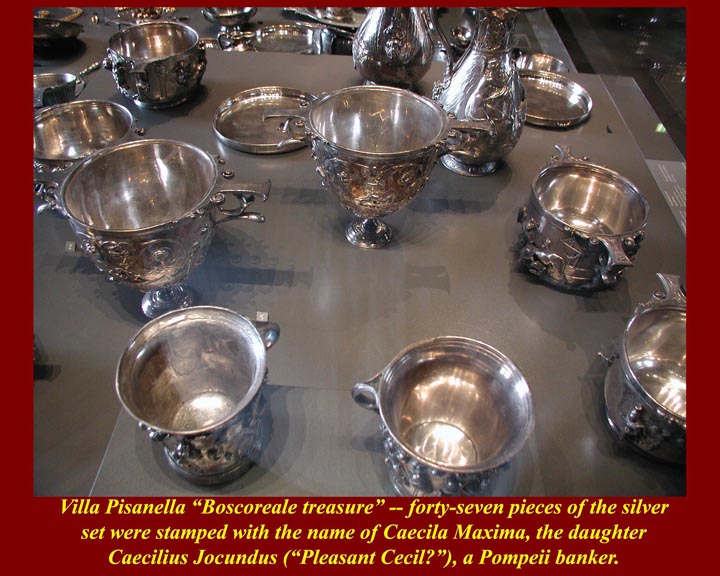 http://www.mmdtkw.org/ALRIVes0632PisanellaTreasure1.jpg
http://www.mmdtkw.org/ALRIVes0632PisanellaTreasure1.jpg
More than one hundred pieces of a serving and eating silver
set were found at the Villa Pisanella. Most of the pieces
are now in the Louvre in Paris.
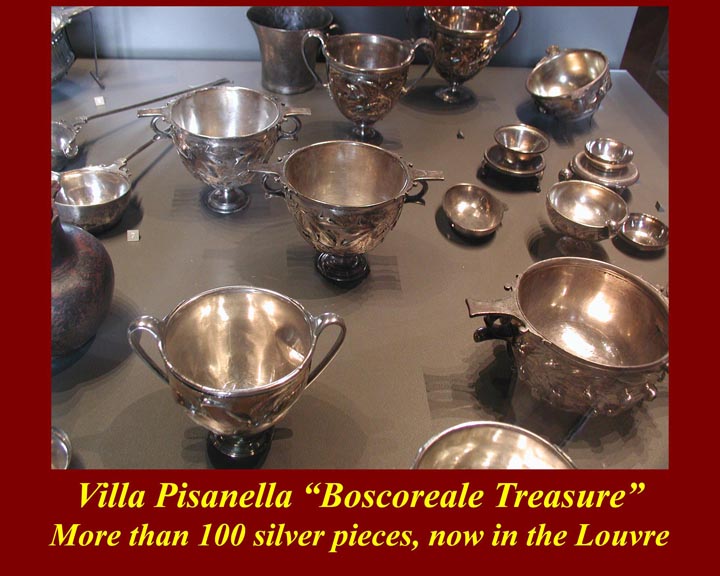 http://www.mmdtkw.org/ALRIVes0633PisanellaTreasure2.jpg
http://www.mmdtkw.org/ALRIVes0633PisanellaTreasure2.jpg
More of the Villa Pisanella Boscoreale silver.
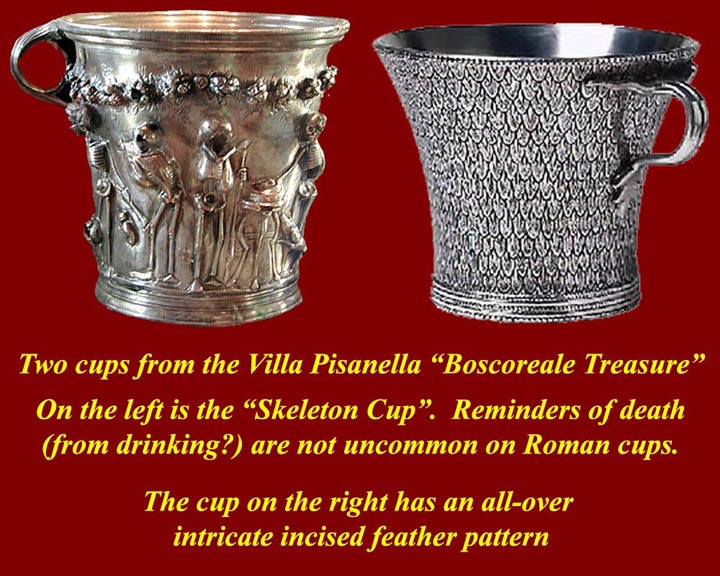 http://www.mmdtkw.org/ALRIVes0634PisanellaSkelFeath.jpg
http://www.mmdtkw.org/ALRIVes0634PisanellaSkelFeath.jpg
Two cups from the Boscoreale treasure. Replicas are
available on line from the Louvre store.
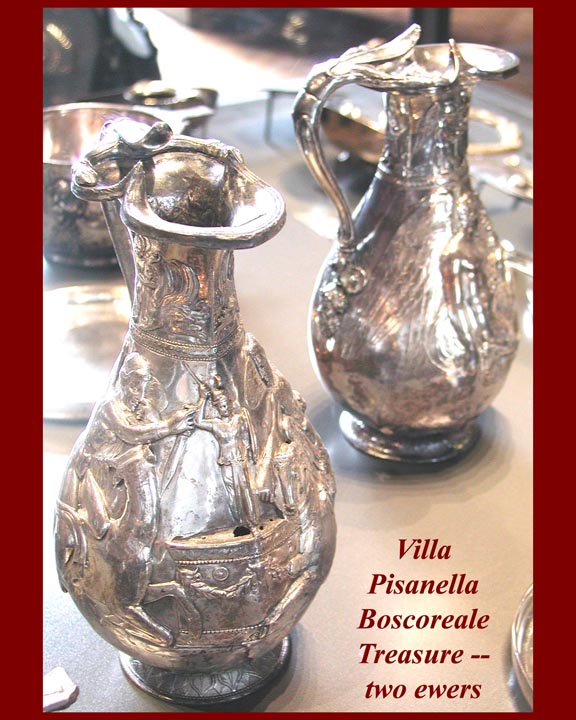 http://www.mmdtkw.org/ALRIVes0635PisanellaTwoEwers.jpg
http://www.mmdtkw.org/ALRIVes0635PisanellaTwoEwers.jpg
Two Boscoreale silver ewers.
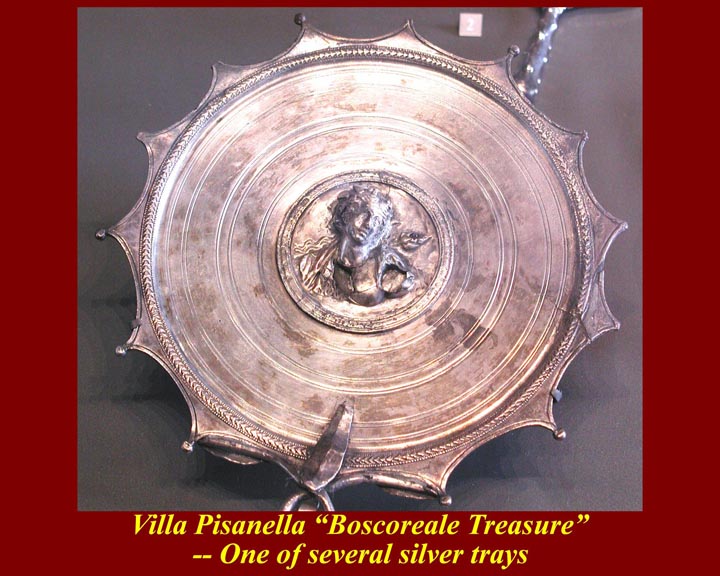 http://www.mmdtkw.org/ALRIVes0636PisanellaTray1.jpg
http://www.mmdtkw.org/ALRIVes0636PisanellaTray1.jpg
One of several large silver trays from the Boscoreale
treasure.
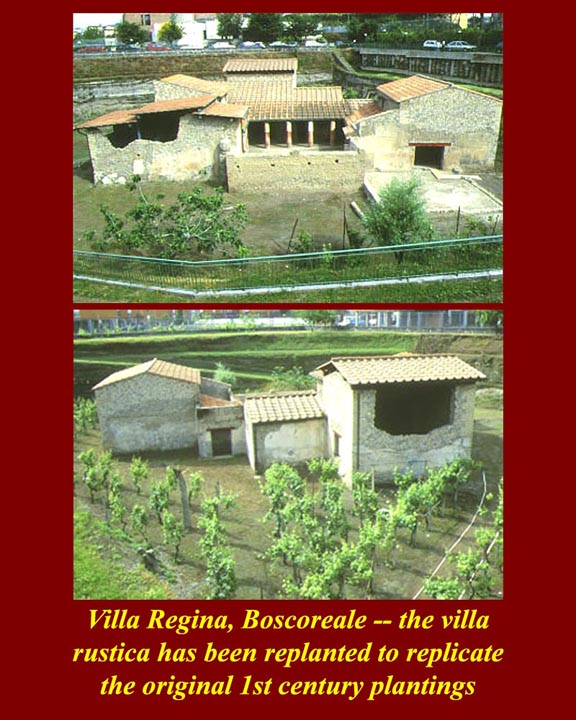 http://www.mmdtkw.org/ALRIVes0637VillaReginaFarm.jpg
http://www.mmdtkw.org/ALRIVes0637VillaReginaFarm.jpg
The Villa Regina at Boscoreale was a working farm with no
entertainment rooms. It has been restored and replanted as
it was before the 79 AD eruption.
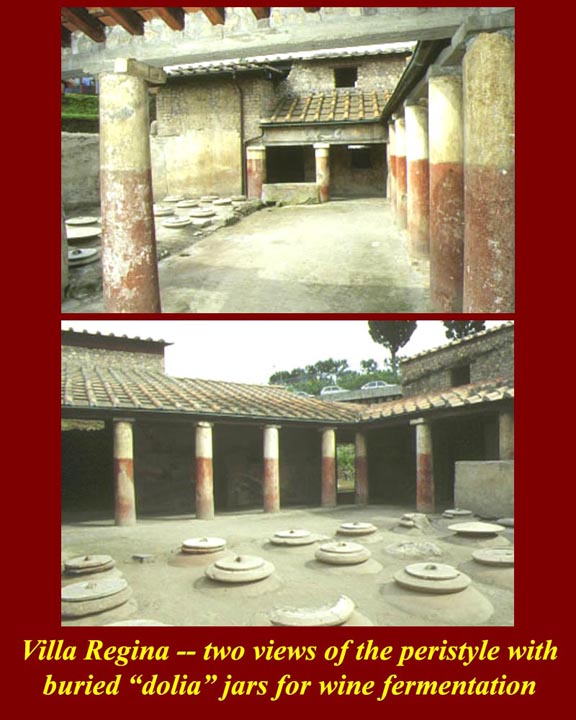 http://www.mmdtkw.org/ALRIVes0638VillaReginaDolia.jpg
http://www.mmdtkw.org/ALRIVes0638VillaReginaDolia.jpg
The main product of the Villa Regina was wine. In this
image are two views of buried dolia, large jugs in which wine was
fermented.
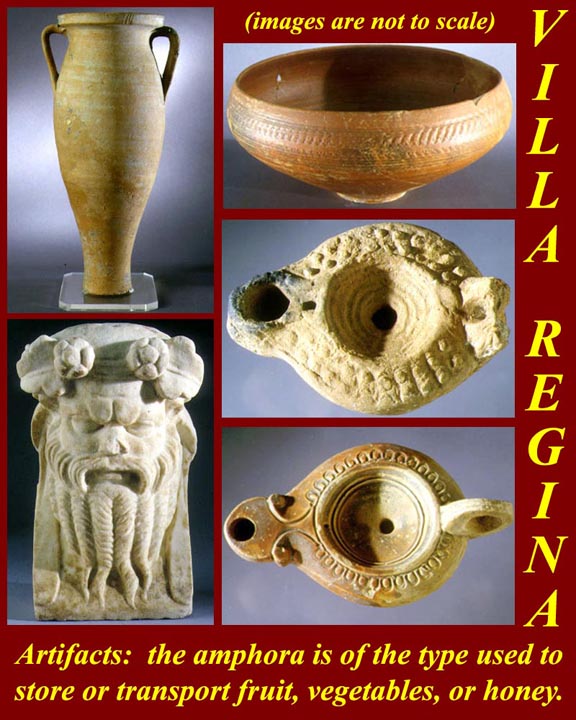 http://www.mmdtkw.org/ALRIVes0639VillaReginaArtifacts.jpg
http://www.mmdtkw.org/ALRIVes0639VillaReginaArtifacts.jpg
Various artifacts from the Villa Regina. The amphora,
upper right, was the type used for storage of honey or
fruit. Below it is a Silenus.
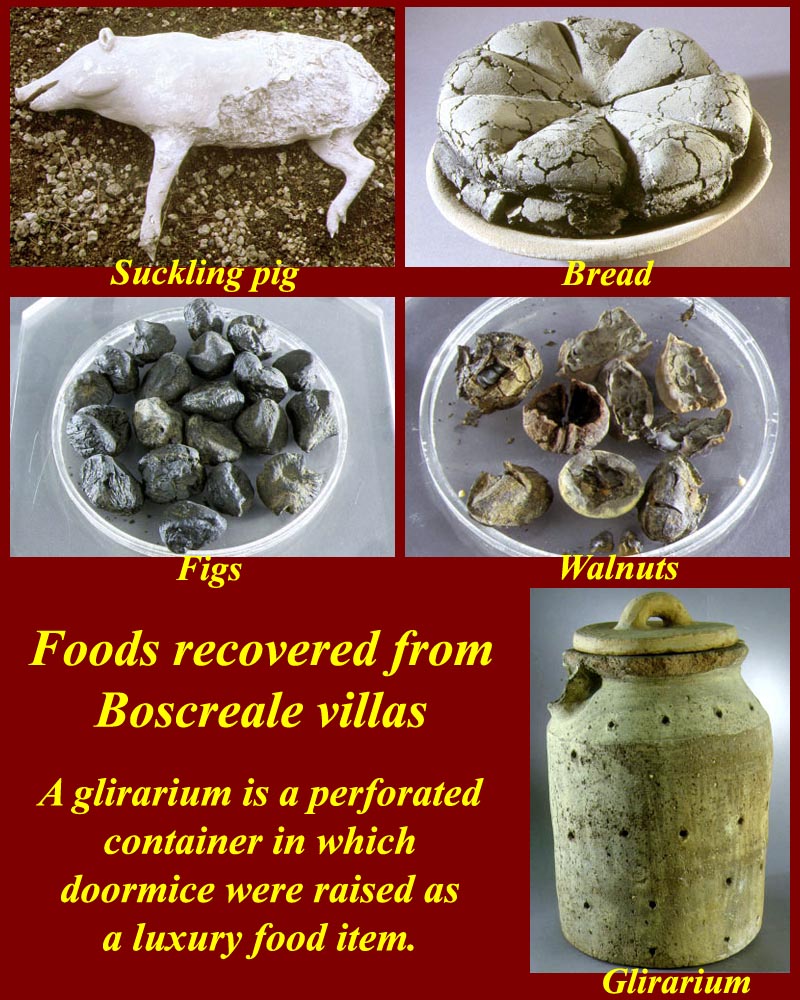 http://www.mmdtkw.org/ALRIVes0639bBoscrealeFoods.jpg
http://www.mmdtkw.org/ALRIVes0639bBoscrealeFoods.jpg
Food items recovered from Boscoreale villas. Bread, figs,
and walnuts are carbonized.
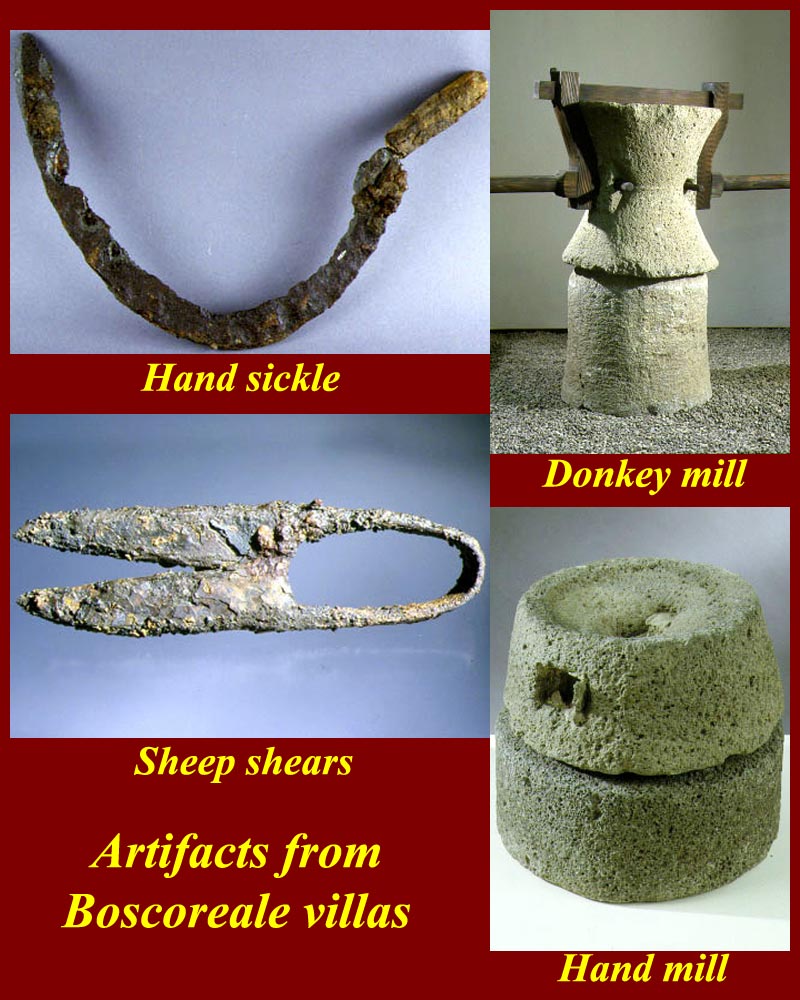 http://www.mmdtkw.org/ALRIVes0639cBoscorealeArtifacts.jpg
http://www.mmdtkw.org/ALRIVes0639cBoscorealeArtifacts.jpg
Artifacts recovered from the Boscoreale villas (not to scale)
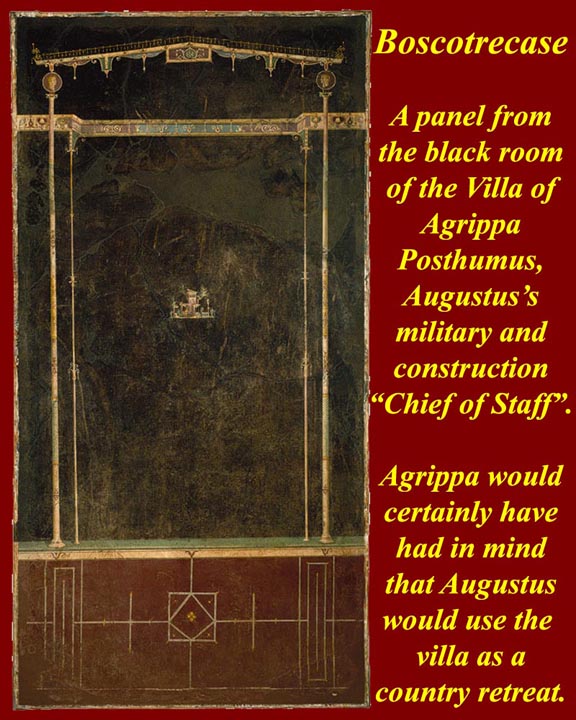 http://www.mmdtkw.org/ALRIVes0640AgrippaBlkRmPanel.jpg
http://www.mmdtkw.org/ALRIVes0640AgrippaBlkRmPanel.jpg
Agrippa's country villa at Boscotrecase was decorated in third
style. The two most important rooms are now called the Black
Room and the White Room. The image shows a single panel from
the black room. Agrippa probably build the retreat for use
by his patron, Caesar Augustus.
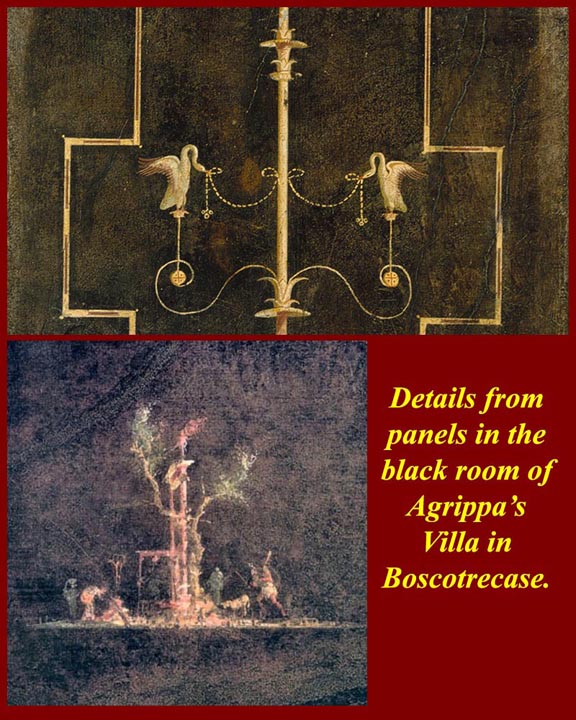
http://www.mmdtkw.org/ALRIVes0641AgrippaBlkRmDetails.jpg
Details -- black room.
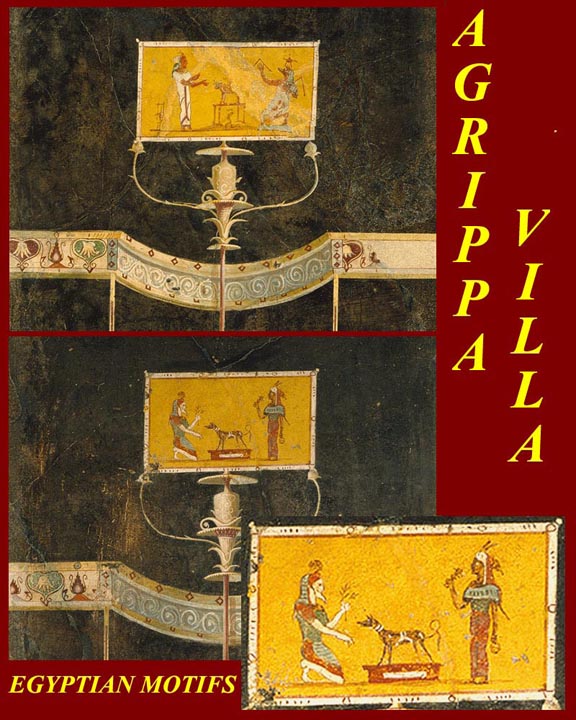 http://www.mmdtkw.org/ALRIVes0642AgrippaEgyptian1.jpg
http://www.mmdtkw.org/ALRIVes0642AgrippaEgyptian1.jpg
Egyptian details -- black room
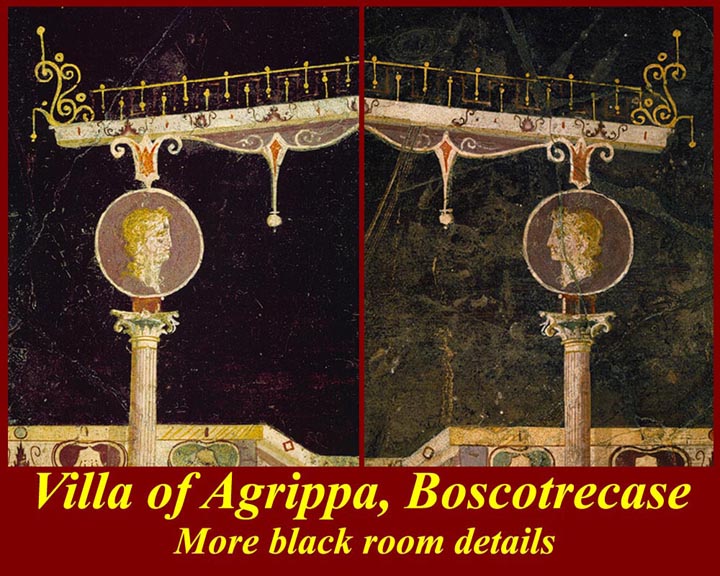 http://www.mmdtkw.org/ALRIVes0643AgrippaEgyptian2.jpg
http://www.mmdtkw.org/ALRIVes0643AgrippaEgyptian2.jpg
More black room details.
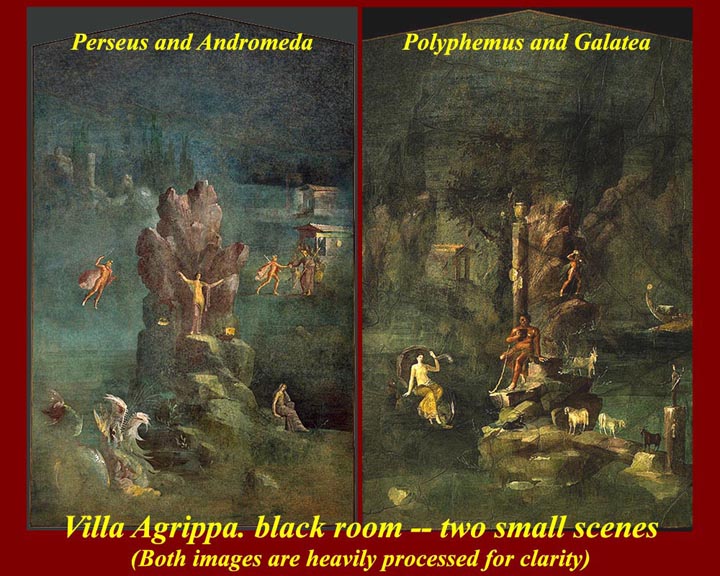 http://www.mmdtkw.org/ALRIVes0644AgrippaBlkRmMythol.jpg
http://www.mmdtkw.org/ALRIVes0644AgrippaBlkRmMythol.jpg
Mythology details -- black room: Perseus and Andromeda /
Polyphemus and Galatea.
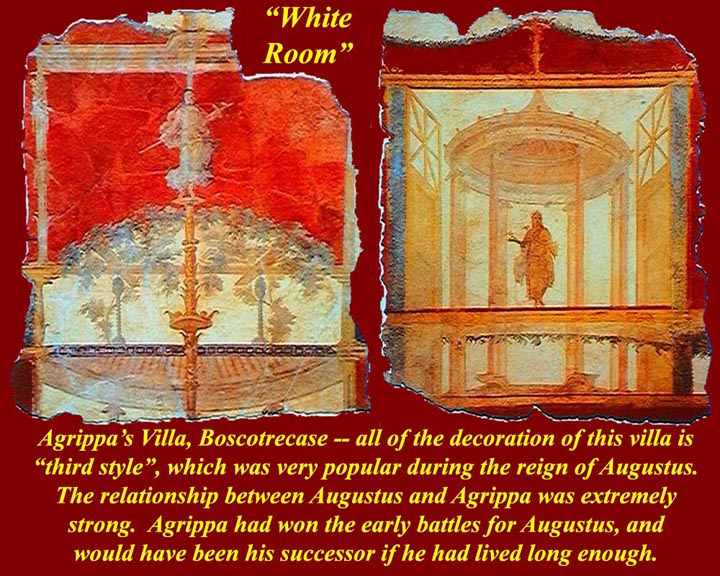 http://www.mmdtkw.org/ALRIVes0645AgrippaWhtRm3rdStyle.jpg
http://www.mmdtkw.org/ALRIVes0645AgrippaWhtRm3rdStyle.jpg
White room decorations.
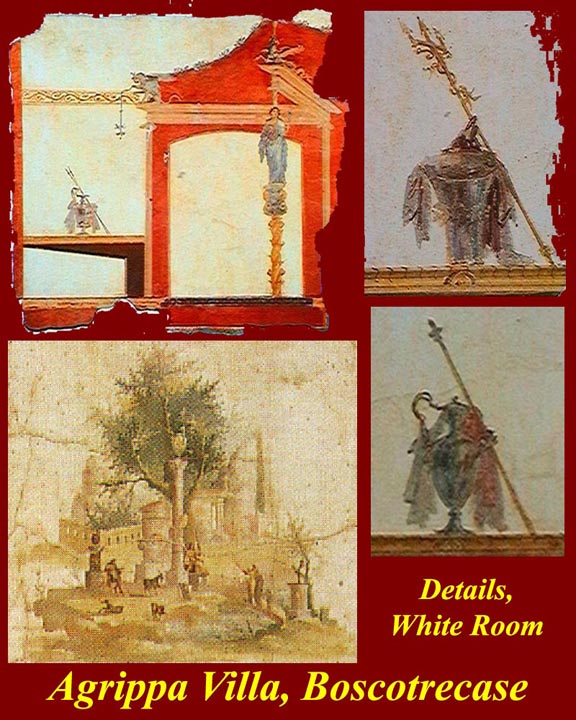 http://www.mmdtkw.org/ALRIVes0646AgrippaWhtRmDetails.jpg
http://www.mmdtkw.org/ALRIVes0646AgrippaWhtRmDetails.jpg
White room decorations.
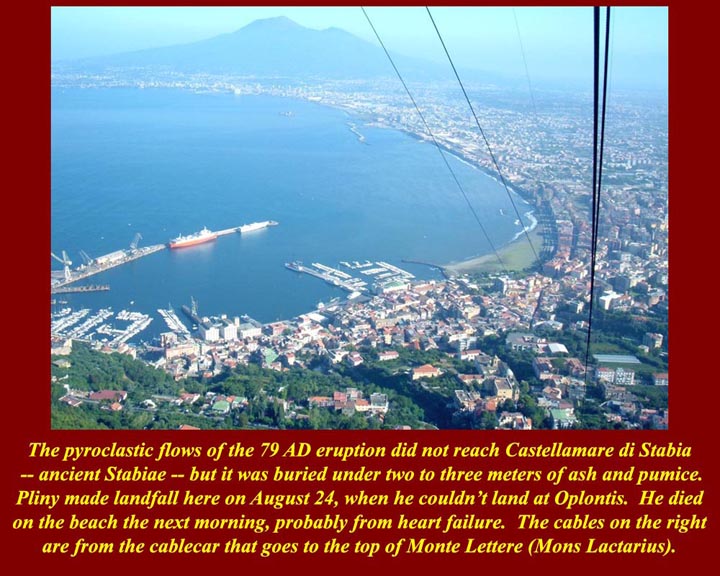 http://www.mmdtkw.org/ALRIVes0647CastellammareDiStabia.jpg
http://www.mmdtkw.org/ALRIVes0647CastellammareDiStabia.jpg
Castellammare di Stabia now stands where ancient Stabiae was
laid out along the south eastern end of the Bay of Naples.
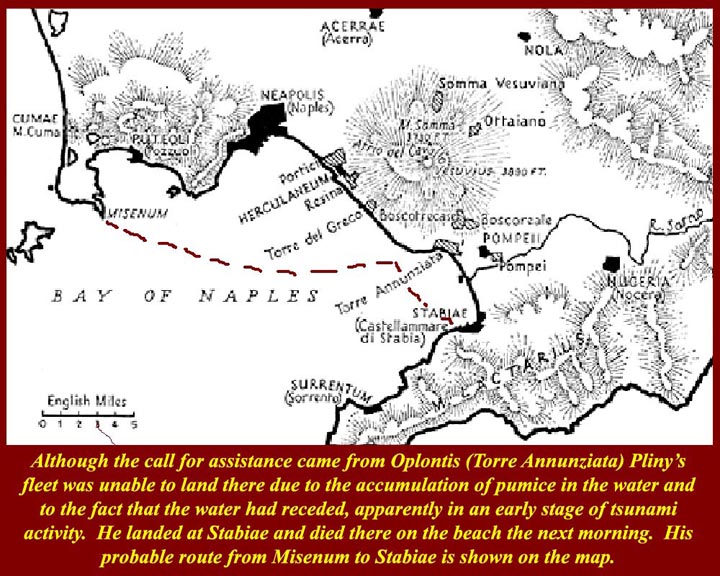 http://www.mmdtkw.org/ALRIVes0648PlinyRouteMap.jpg
http://www.mmdtkw.org/ALRIVes0648PlinyRouteMap.jpg
On "Eruption Day" of 79 AD Pliny was summoned to rescue
the wife of a friend at Oplontis (Torre Annunziata). He was
unable to put ashore there because of the accumulation of volcanic
debris -- probably floating pumice -- and because the water may
have receded in early-stage tsunami activity. He went ashore
at Stabiae and died there the next morning, probably of heart
failure.
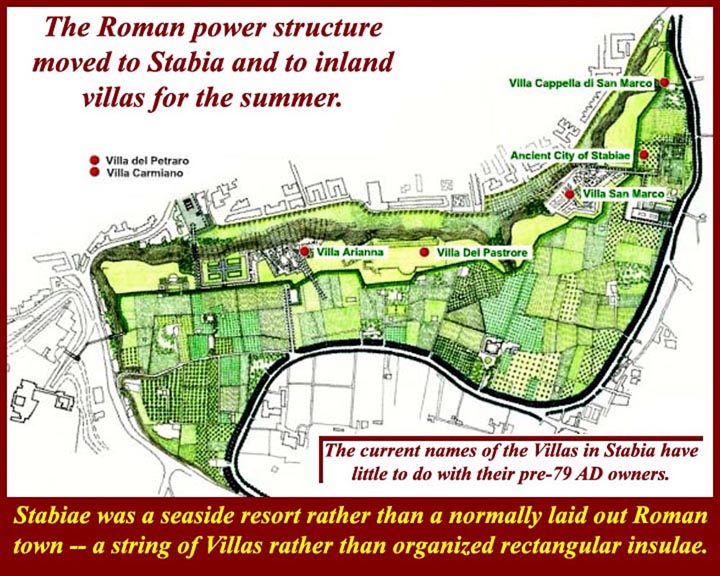 http://www.mmdtkw.org/ALRIVes0649StabiaeVillasMap.jpg
http://www.mmdtkw.org/ALRIVes0649StabiaeVillasMap.jpg
A modern internet tourist map of the villas at Stabiae:
The map shows only the few that were excavated, but they probably
were strung like pearls, side by side along a low cliff that was
separated from the shore by a narrow beach. The shoreline is
now more than a mile from the ruins, mostly as a result of
volcanic deposits. The Pyroclastic flows stopped short of
Stabiae but it was directly in the path of the Plinian ashfalls.
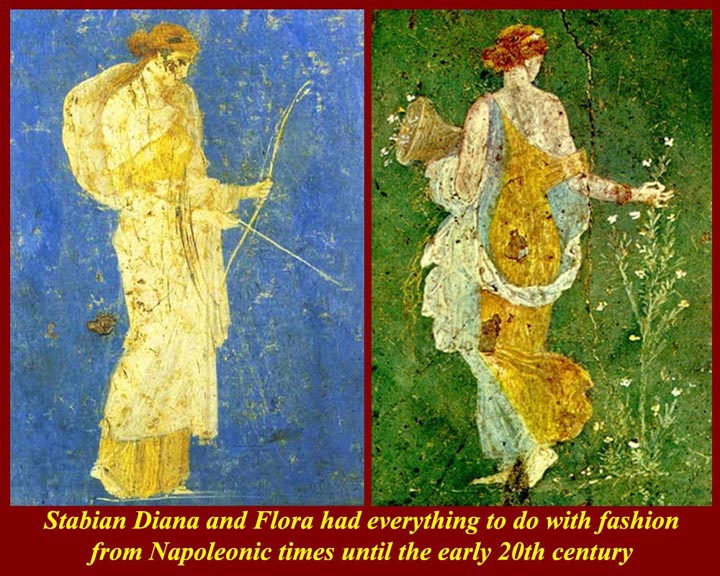 http://www.mmdtkw.org/ALRIVes0650DianaFlora.jpg
http://www.mmdtkw.org/ALRIVes0650DianaFlora.jpg
Stabiae's two famous fashion plates inspired 18th, 19th, and
20th century designers of women's clothing. Also influential
were images of female worshippers depicted in frescoes at the Isis
temple in Pompeii. See "Empire style and derivatives at
https://en.wikipedia.org/wiki/Empire_silhouette.
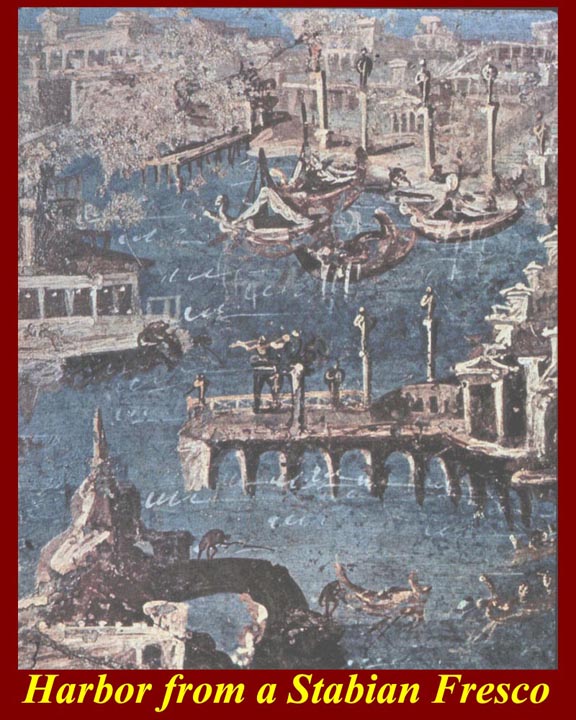 http://www.mmdtkw.org/ALRIVes0651HarborScene.jpg
http://www.mmdtkw.org/ALRIVes0651HarborScene.jpg
A fresco from one of the Stabian villas shows the Stabiae
harbor.
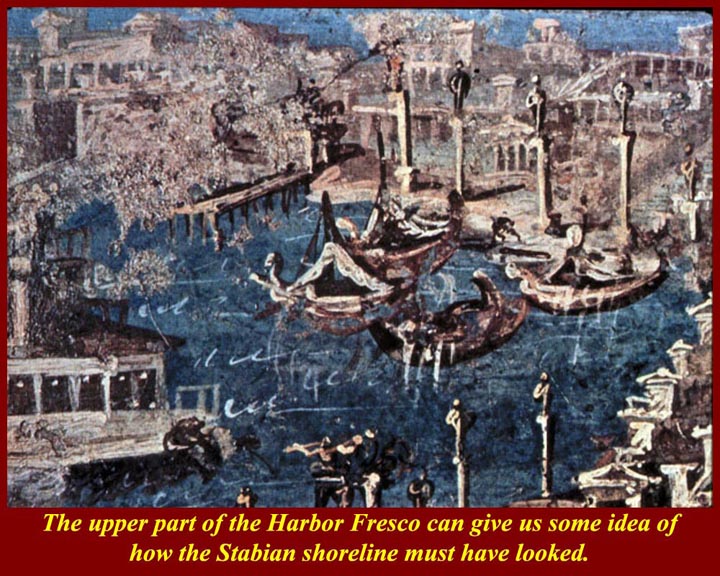 http://www.mmdtkw.org/ALRIVes0652HarborFrescoShoreline.jpg
http://www.mmdtkw.org/ALRIVes0652HarborFrescoShoreline.jpg
A closer view of the upper part of the same fresco gives an
idea of what the Villas looked like along the shore.
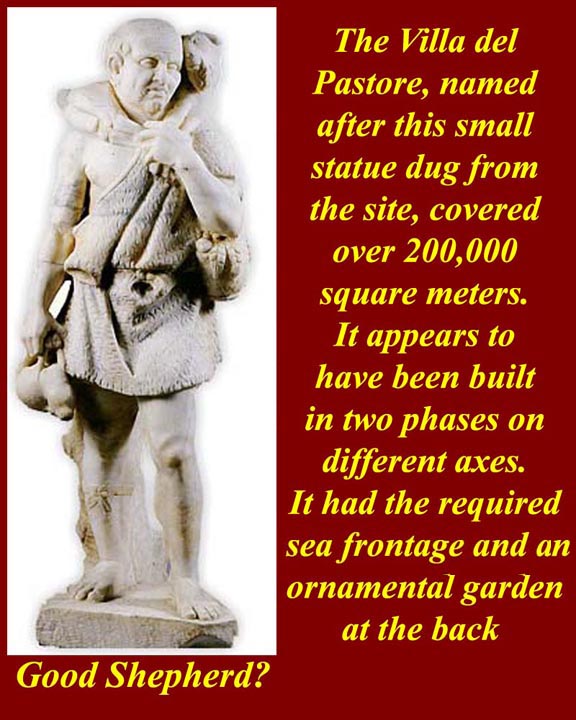
http://www.mmdtkw.org/ALRIVes0653StabiaVillaPastore.jpg
From the Villa Pastore (Villa of the Shepherd) comes this
non-Christian image of the "Good Shepherd". The villa
appears to have built in two phases on different axes.
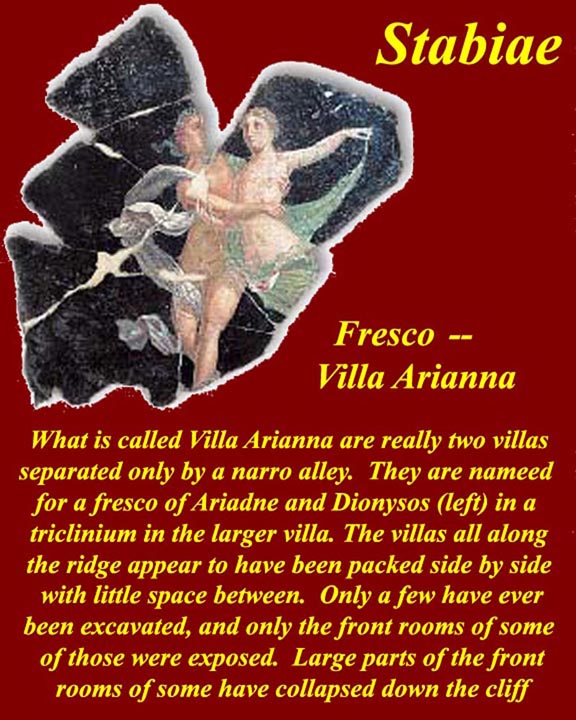 http://www.mmdtkw.org/ALRIVes0654StabiaeVillaArianna.jpg
http://www.mmdtkw.org/ALRIVes0654StabiaeVillaArianna.jpg
What is now identified as the Villa Arianna is actually 2
adjacent villas. In the larger of the two is a fresco of
Dionysus and Ariadne, shown here.
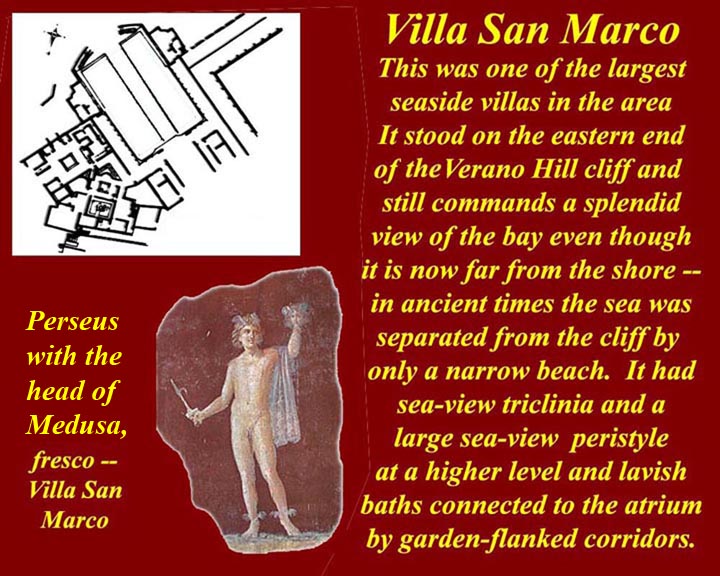
http://www.mmdtkw.org/ALRIVes0655StabiaeVillaSMarco.jpg
The Villa San Marco is at the end of the string of pearls at
the eastern end of the low cliff. The fresco has been
miss-identified as Mercury; it is clearly Perseus with the
head of Medusa.
Aided by
Hermes and
Athena, Perseus pressed the
Graiae, sisters of the Gorgons, into
helping him by seizing the one eye and one tooth that the sisters
shared and not returning them until they provided him with winged
sandals (which enabled him to fly), the cap of Hades (which
conferred invisibility), a curved sword, or sickle, to decapitate
Medusa, and a bag in which to conceal the head. (According to
another version, the Graiae merely directed him to the Stygian
Nymphs, who told him where to find the Gorgons and gave him the
bag, sandals, and helmet; Hermes gave him the sword.)


























































